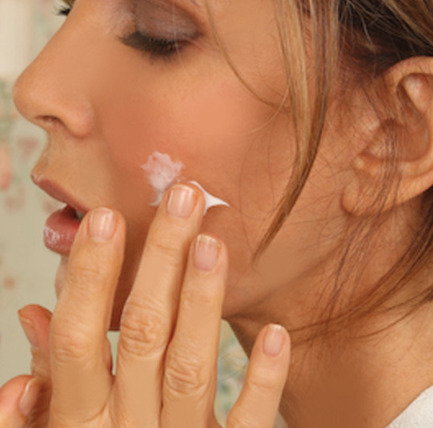Learn About Skin Care
Behind the Research and Development
Bradley Allen, MD is a renowned pediatric heart surgeon and a pioneering medical researcher. For over 25 years he has been doing innovative experimental medical research at several universities. Dr. Allen has written nearly 100 scientific papers, 7 book chapters, and his research has been featured in several television news stories. A Visiting Professor of Surgery at the UCLA David Geffen School of Medicine, Dr. Allen has been a sought after lecturer at medical conferences and events in the US, Europe and Asia.
Last but not least, he's also Jaclyn's husband.
ANTIOXIDANTS Antioxidants work by scavenging (neutralizing) oxygen free radicals which can cause cellular damage, leading to the signs of aging. When our body uses oxygen, it produces free radicals, which are oxygen molecules with one less electron. These oxygen free radicals can then start a deadly chain reaction that damages cells. Antioxidants act as "free radical scavengers" to terminate these chain reactions, and hence prevent and repair damage done by free radicals. Some skin experts believe all aspects of aging, including wrinkling, are caused by free-radical damage, and that if there is a fountain of youth, antioxidants are probably part of the formula. Furthermore, there is increasing evidence that combinations of vitamins and antioxidants have additive effects that provide enhanced efficacy compared with individual compounds (antioxidants). That is why Jaclyn integrates a collection of antioxidants into her creams to take advantage of these powerful combinations.

VITAMIN C Vitamin C or L-ascorbic acid is a vital ingredient that scavenges and destroys oxygen free radicals in the epidermis (outer layer of skin), and has been shown to provide marked improvement in aged or sun damaged skin. It provides protection against damage by UV (sun) radiation, and may even help prevent skin cancer. Vitamin C also improves skin elasticity, stimulates collagen synthesis (to reduce lines and wrinkles), reduces erythema (redness), and suppresses cutaneous (skin) pigmentation (lightening hyperpigmentation or sun spots). By stimulating collagen formation, Vitamin C actually treats wrinkles after they appear, whereas most antioxidants only prevent anti-aging effects (wrinkles) by neutralizing free radicals. Vitamin C helps regenerate oxidized Vitamin E (vitamin E that has interacted with an oxygen radical), and both Vitamin C & E have been shown in scientific studies to enhance protection against (photo-aging) sun damage from UVA and UVB rays, making them valuable additives to sunscreens.
VITAMIN E
Vitamin E (chemical name tocopherol) is one of the most effective, well-known, and researched antioxidants. Topical vitamin E is a powerful antioxidant that has been shown to a) protect the skin from ultraviolet light damage and reduce free radical production upon exposure to UVA rays and other stress, b) increase the efficacy of active sunscreen ingredients, c) scavenge oxygen free radicals that can damage the skin, d) reduce water loss from the skin, and e) strengthen the skin’s barrier function. As important as vitamin E is for skin, it is usually best used in combination with other antioxidants, including vitamin C, coenzyme Q10, as there is increasing evidence that combining antioxidants provides enhanced efficacy compared with individual compounds.

COENZYME Q10
Coenzyme Q10, also called CoQ10 or ubiquinone, is a natural compound found within every cell, and it has at least two important roles. First, CoQ10 helps generate energy (ATP) within a cell, and second it is a potent antioxidant. Unfortunately, as we age, our bodies produce less CoQ10. In most people over the age of thirty, levels of CoQ10 in the skin are already below optimum, resulting in reduced ability to produce collagen, elastin (both substances that support and give elasticity to the skin), and other important skin elements. In other words, with lower levels of coenzyme Q10, the skin has a tougher time renewing itself. In addition, CoQ10-depleted skin may be more prone to damage by oxygen free radicals, which are particularly abundant in the skin, since it is directly exposed to the elements including the sun. Thus, CoQ10 may help boost skin repair and regeneration, as well as reduce free radical damage.
Coenzyme Q10 is a small molecule that can relatively easily penetrate into skin cells. Studies now show that it can effectively counteract free radical damage and provide significant protection against UVA-induced depletion of the cell membrane. In other words, it will prevent damage to collagen and elastin production (two substances that support the skin) and help avoid HYPERLINK "http://www.pioneerthinking.com/nk_q10.html" \t "undefined" wrinkles. Indeed, a study from Germany in 1999 demonstrated that daily use of topical CoQ10 for 6 weeks reduced crow’s feet (wrinkles around the eye) by 27 percent, and after 10 weeks, by 43 percent. A more recent study (2008) from Japan found that CoQ10 reduced wrinkle from solar (sun) radiation by inhibiting oxygen free radical formation, DNA (gene) damage, and protecting lower skin (dermal) components (fibroblasts), leading to rejuvenation (reduction) of wrinkles.
GREEN TEA
Green Tea isn't just for drinking; it's also good for the HYPERLINK "http://www.articlesbase.com/skin-care-articles/green-tea-is-good-for-skin-care-953292.html" \t "undefined" skin. Green tea contains polyphenols, and the polyphenols found in tea mainly belong to the subtype called catechins. These catechins are potent antioxidants; up to 20 times more powerful than Vitamin C and 200 times more powerful than Vitamin E in protecting against free
radical damage. Green tea also has potent anti-inflammatory and
anti-bacterial properties, and a 2003 study showed topical green tea
cream was as good as benzoyl peroxide in treating acne, with fewer side
effects. These anti-inflammatory properties can help smooth affected
areas, resulting in more even skin tone, soothed irritation, and
reduction in redness. Lastly, topical green tea has been shown to reduce
sun damage, presumably by quenching free radicals and reducing
inflammation.
Exfoliation:
The Basics
The Basics The skin you see is actually dead skin cells. These cells are continually flaking off, and in fact, you lose about 35,000 dead skin cells each minute. In the course of 1 year each person sheds around 10 pounds of skin cells, which accounts for most of the dust in your home. Our skin continually exfoliates itself about every 28 days, a naturally occurring process that slows down as we age. Many people over the age of 30 develop dull, lifeless looking skin because their stratum corneum (topmost layer of the skin consisting of mostly dead cells) becomes too thick and uneven with mounds of dead skin. The rough uneven texture is almost like stucco on a wall or ceiling. Those same dead cells can also accumulate brown pigment and discolor your skin. The result is dull, drab, older looking skin.
Exfoliation accelerates skin turnover by removing the thickened accumulation of dead cells on the outer surface of the skin (a.k.a. stratum corneum) to expose fresher mostly living cells, smoothing out the skin, and giving it back luster and brightness. Exfoliation also evens out the color of your skin, and helps prevent and treat acne by unclogging pores. It is a noninvasive way to diminish the appearance of fine lines, while helping to restore a smoother texture, and making your skin healthier. Besides fresher, brighter looking skin, exfoliation allows better penetration of active ingredients in skin care products, and for people with excessively oily skin, a varying degree of reduction in oil secretion. Ordinarily, exfoliation is more commonly used to remove the buildup of dead cells in older skin, and in younger skin, more for excess oil and to unclog pores. The potential side effects include irritation and increased sensitivity to the sun.
In general, exfoliation can be accomplished by either using chemical or physical agents. Physical exfoliants (scrubs) remove dead cells through friction, whereas chemical exfoliants remove dead skin cells by dissolving the "glue" that binds them to other cells. Both are effective, but commonly, physical exfoliants are better for sensitive skin, and chemical for people with acne. It is important with physical exfoliators not to over scrub, but to massage and “polish” the skin. With chemical exfoliators, you usually need to build up a tolerance, as the low (acid) ph and high concentration of chemicals needed to be effective (see below) can cause skin irritation.
Jaclyn chooses to use a physical exfoliator in her routine, because she
feels physical exfoliation is better for her sensitive skin...
Jaclyn chooses to use a physical exfoliator in her routine, because she feels physical exfoliation is better for her sensitive skin, and because she is already using Retinol, which also helps exfoliate or shed dead surface skin. Moreover, with her sensitive skin, Jaclyn is worried that using both retinol and a chemical exfoliator would cause too much skin irritation. Jaclyn certainly does not want to reduce her use of retinol, as independent studies have shown that retinoids overall are much more effective at reversing the signs of aging and stimulating growth of new collagen than the hydroxy acids used in most chemical exfoliators. Nevertheless, women with very oily skin and/or acne problems could consider using a glycolic acid (chemical) product to exfoliate instead of the physical exfoliator Jaclyn prefers. In that case, they should probably use the chemical exfoliator in the morning, and reserve the retinol product for night to help limit excessive skin irritation.
The most common chemical exfoliators use alpha hydroxy acid (AHA) or beta hydroxy acid (BHA) to breakdown surface skin cells. The major difference is that AHAs are water soluble, while BHAs are oil soluble. In general this means that BHAs can better penetrate the oil in pores, making them superior for treating acne, whereas AHAs are better for treating thickened dry skin where breakouts are not a problem. However to be effective and work properly, the hydroxyl acids must be used in adequate concentrations (AHA 8-10%, BHA 1-2%), and the pH must be acidic (pH>3.5). For many people, this makes these substances irritating, especially women with sensitive skin. If the pH of the AHA or BHA cream (or cleanser) is not acidic, or lower concentrations are used, they won’t work nearly as well to remove the dead skin. Therefore, be careful about using a chemical exfoliator that promotes the beneficial effects of glycolic acids without knowing the concentration and the pH of the product. Moreover, AHA and BHA’s must be left on the skin for a period of time so they can be absorbed into the skin, where they work over time to loosen the “glue” that binds the skin cells. This means that cleansers that contain AHA or BHA’s probably provide little benefit, as they are washed away almost immediately when you rinse your face.
In general, most women only need to exfoliate their face once or twice a week. Rarely, women with extremely sensitive skin may want to exfoliate still less (every 14 days), and even people with oily skin seldom need to exfoliate more than 3-4 times per week. After this, the dead skin has been removed, and the effects are diminished. An effective sunscreen is also mandatory if you exfoliate, as it can sensitize the skin to the sun. However, sunscreen should really always be used regardless of if you exfoliate, as sun damage is the number one cause of aging skin.
Finally, to avoid a source of frequent confusion on this topic, chemical exfoliation is not the same as a chemical peel, even though both may use the same hydroxyl acids (AHA or BHA). Deep chemical peels are aggressive treatments done infrequently and usually by professionals. Their mechanism of action is different; they are not simply intense versions of exfoliation. Compared to over the counter chemical exfoliators, deep chemical peels use a much higher concentration of glycolic or hydroxy acids. The idea behind deep chemical peels (along with laser peels) is not to strip the dead cells from the epidermis (as happens with exfoliation), but to create controlled trauma to the dermis, the deeper layer of skin responsible for structural integrity. The subsequent wound healing response and skin remodeling in the dermis then helps to lessen and/or remove some wrinkles.
|






